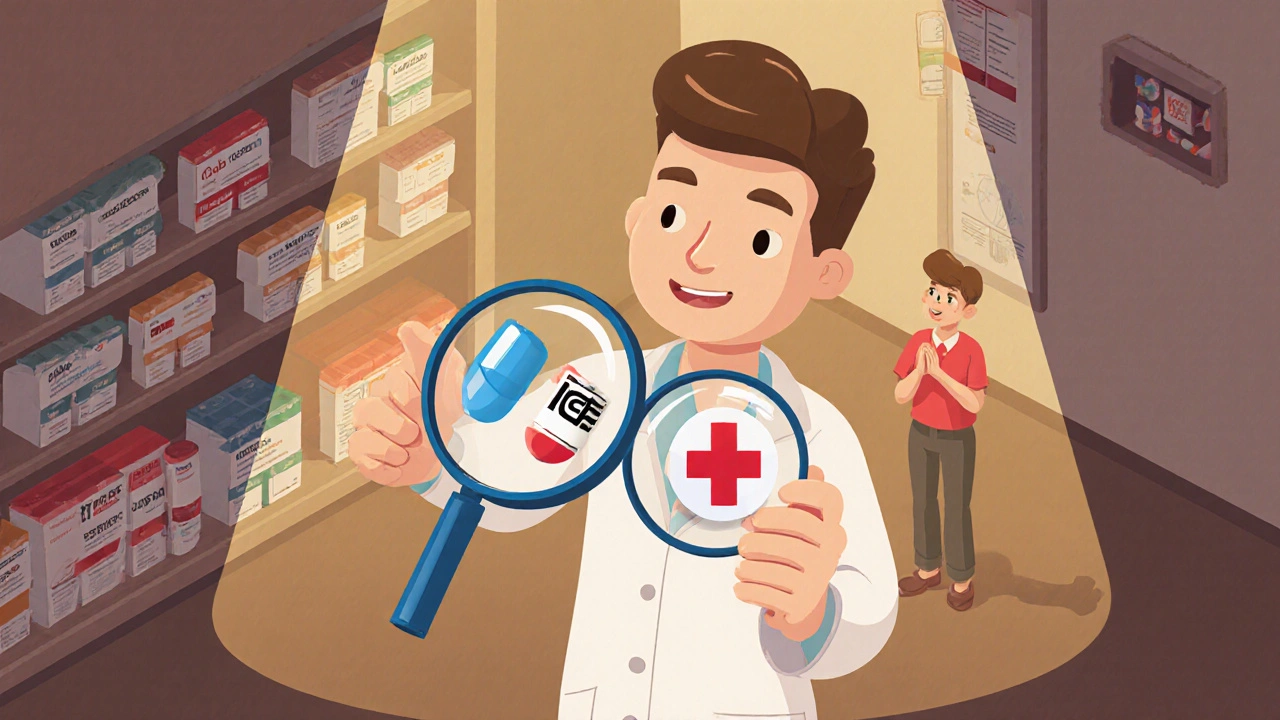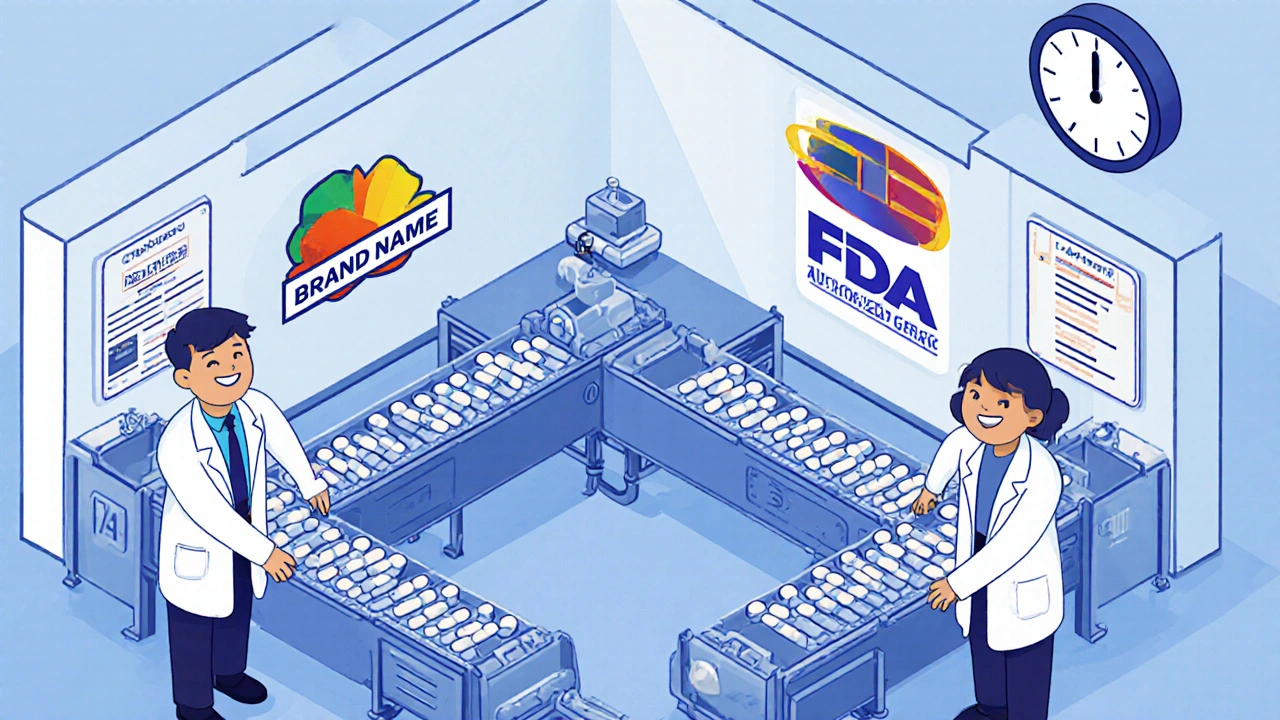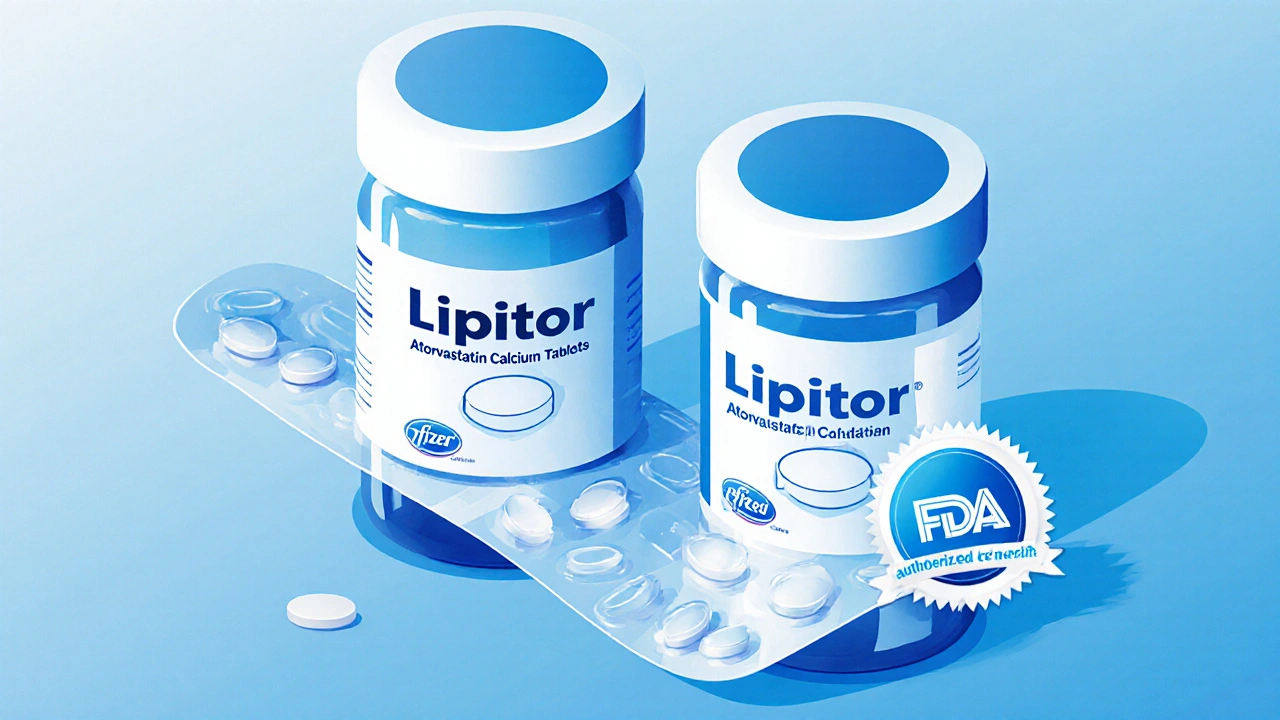Have you ever picked up a prescription and noticed the pill looks different - maybe a different color or shape - but the name on the bottle is the same as your brand-name drug? You might think it’s a generic version. But what if it’s not a generic at all? What if it’s the exact same drug, just with a different label? That’s an authorized generic.
What Exactly Is an Authorized Generic?
An authorized generic is not a copy. It’s not a knockoff. It’s the real thing - made by the same company that makes the brand-name drug, in the same factory, with the same ingredients, same strength, same shape, same everything. The only difference? The label doesn’t have the brand name on it.
For example, if you take Lipitor for cholesterol, the brand version is made by Pfizer. But Pfizer also makes an authorized generic version of atorvastatin - the same pill, same batch, same packaging - but sold under a different name, like "Atorvastatin Calcium Tablets" with no "Lipitor" logo. It’s identical. No tricks. No compromises.
This isn’t some loophole. It’s written into U.S. law. The FDA defines an authorized generic as a drug approved under the original brand’s New Drug Application (NDA), but sold without the brand name. That means it skips the usual generic approval process. No need to prove it works the same way - because it is the same way.
How Is It Different From Regular Generics?
Regular generics are made by other companies. They have to go through the Abbreviated New Drug Application (ANDA) process. That means they must show they’re bioequivalent to the brand drug - meaning they work the same in your body. But they’re allowed to use different inactive ingredients. That’s why you might see a generic version of your pill that’s blue instead of green, or oval instead of round. Sometimes those inactive ingredients cause minor differences in how the pill dissolves or how it feels in your stomach.
Authorized generics don’t have that issue. They use the exact same inactive ingredients. Same binder. Same coating. Same fillers. Same everything. Because they’re produced under the brand’s NDA, they’re not listed in the FDA’s Orange Book - the official directory of approved generics. That’s why pharmacists sometimes have to double-check: "Is this really the same?"
And here’s the kicker: authorized generics often cost the same as regular generics. Sometimes even less. But they’re not cheaper because they’re lower quality. They’re cheaper because they’re not paying for advertising, fancy packaging, or brand loyalty.
Why Do Brand Companies Make Authorized Generics?
It sounds strange. Why would Pfizer sell its own drug under a generic label? The answer is simple: money.
When a brand drug’s patent expires, other companies can make generics. But under the Hatch-Waxman Act of 1984, the first company to file for a generic version gets 180 days of exclusive rights to sell it. That’s a huge financial incentive - and it’s meant to encourage competition.
But here’s where things get tricky. If the brand company launches its own authorized generic right when the patent expires, it can undercut that first generic company. Suddenly, the company that spent millions challenging the patent is now competing against the brand itself - at the same price. That’s called market distortion. And it’s happened dozens of times.
Companies like Pfizer (through Greenstone), Procter & Gamble (through Prasco), and others have built entire divisions just to make authorized generics. They’re not trying to be evil. They’re trying to protect their revenue. And it works. When an authorized generic hits the market, the price of the brand-name drug often drops - fast.

What Does This Mean for You as a Patient?
Here’s the good news: you’re getting the exact same medicine. No risk. No trade-off. Your body won’t know the difference.
But here’s the confusion: you might get an authorized generic and think it’s a different drug. Maybe your pharmacist switched it without telling you. Maybe you notice the pill looks different. You might panic. You might call your doctor. You might even refuse to take it.
Don’t. If it’s an authorized generic, you’re safe. The FDA says it’s therapeutically equivalent - meaning it’s just as effective and just as safe. The only thing that changed is the label.
But you should still ask. When you get your prescription filled, check the label. If it says "Atorvastatin Calcium" and the manufacturer is "Pfizer," that’s an authorized generic. If it says "Watson Pharmaceuticals," that’s a regular generic. Both are fine. But only one is the original brand’s product.
Some patients report better results with authorized generics - not because they’re stronger, but because they’re consistent. If you’ve been on Lipitor for years and your body is used to that exact formulation, switching to a regular generic with different fillers might cause minor side effects. An authorized generic avoids that entirely.
Why Aren’t Authorized Generics Listed in the Orange Book?
The FDA’s Orange Book is the go-to resource for pharmacists to find out which generics are equivalent to brand drugs. But authorized generics aren’t in there. Why? Because they’re not generics under the law. They’re the brand drug, just sold under a different label.
This creates real problems for pharmacies. If a pharmacist doesn’t know about authorized generics, they might think the pill isn’t approved. Or worse - they might think it’s counterfeit. That’s why many pharmacists rely on the FDA’s separate List of Authorized Generic Drugs, which is updated regularly but isn’t as widely known.
It’s also why you might hear your pharmacist say, "I’ve never dispensed this before." That doesn’t mean it’s unsafe. It just means they’re not used to seeing it.

How to Spot an Authorized Generic
Here’s how to tell if your prescription is an authorized generic:
- Check the manufacturer name on the bottle. If it’s the same company that makes the brand drug (like Pfizer, Merck, or AbbVie), it’s likely an authorized generic.
- Look for the brand name on the pill. If the pill looks identical to the brand version, but the label says something like "Generic Atorvastatin," it’s probably an authorized generic.
- Ask your pharmacist: "Is this an authorized generic?" They can check the FDA’s list or their internal database.
- Compare the pill’s color, shape, and imprint to the brand version. If they match exactly, it’s a strong sign.
Some authorized generics even have the same imprint code as the brand - just with a different color. For example, a 10mg Lipitor tablet is white and oval with "Pfizer" on one side. The authorized generic might be blue and oval with the same imprint. Same drug. Different color. No difference in effect.
What’s the Future of Authorized Generics?
More brand drugs are losing patent protection every year. That means more opportunities for authorized generics. Companies like Pfizer and Novartis are already using subsidiaries to launch these versions as soon as the patent clock runs out.
Some lawmakers are pushing to change the rules. Critics argue that authorized generics undermine the Hatch-Waxman Act’s goal: to encourage independent generic manufacturers to challenge patents. If the brand company can just jump in and crush the first generic, why would anyone risk the legal battle?
But for now, authorized generics are here to stay. The FDA still recognizes them. Pharmacies still dispense them. Patients still benefit from them.
The real question isn’t whether they’re safe - they are. The real question is whether they’re fair. But for you, the patient? You get the same medicine, at a lower price. And that’s not a bad deal.
What to Do If You’re Switched to an Authorized Generic
If your pharmacist switches your prescription to an authorized generic, here’s what to do:
- Don’t panic. You’re still getting the same drug.
- Check the label. Look for the manufacturer. If it’s the same as the brand, you’re fine.
- Compare the pill to your old one. If it looks identical, no need to worry.
- If you notice new side effects, call your doctor. But don’t assume it’s the drug - it could be stress, diet, or something else.
- Ask your doctor to write "Dispense as Written" on the prescription if you prefer the brand or want to avoid switches.
Most insurance plans don’t care if it’s an authorized generic. They’ll cover it at the generic tier. So you save money - and get the same medicine.
Are authorized generics as safe as brand-name drugs?
Yes. Authorized generics are identical to their brand-name counterparts in every way - same active ingredients, same inactive ingredients, same manufacturing process, same quality control. The FDA considers them therapeutically equivalent. There is no difference in safety or effectiveness.
Why does the pill look different if it’s the same drug?
The only allowed difference is the label and sometimes the color or imprint on the pill - to distinguish it from the brand version. This is required by law to avoid confusion. But the drug inside is exactly the same. The shape, size, and coating may vary slightly for manufacturing reasons, but the active ingredient and its release profile are unchanged.
Can I ask my doctor to prescribe an authorized generic?
You can ask, but doctors usually don’t specify. Prescriptions are written for the drug name (like "atorvastatin"), not the brand or generic version. The pharmacist fills it based on cost, availability, and insurance rules. If you want to ensure you get an authorized generic, ask your pharmacist directly when picking up your prescription.
Are authorized generics cheaper than regular generics?
Often, yes - sometimes even by a few dollars. Because they’re made by the brand company, they enter the market quickly and avoid the pricing wars that happen between multiple generic makers. This can drive prices down faster. But in many cases, they cost the same as regular generics. Either way, you’re paying less than the brand.
How do I know if my drug has an authorized generic?
Check the FDA’s List of Authorized Generic Drugs online or ask your pharmacist. Many popular drugs - like Lipitor, Singulair, and Propecia - have authorized generics. If the manufacturer on your bottle matches the brand’s parent company (like Pfizer, AbbVie, or Johnson & Johnson), it’s likely an authorized generic.
If you’re on a long-term medication and you’ve noticed changes in how you feel after switching to a new pill - whether it’s a regular generic or an authorized generic - talk to your doctor. But don’t assume the drug is the problem. More often than not, it’s your body adjusting - or something else entirely.
Bottom line: authorized generics aren’t a trick. They’re a transparent, legal way to get the exact same medicine at a lower price. And if you’re lucky enough to get one? You’re getting the best of both worlds.
